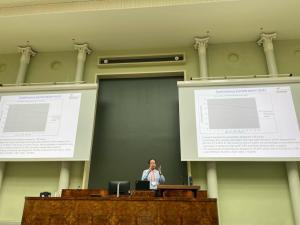Aston University Professor Presents New Research on AI-based Software-Defined Neuromorphic Computing at IEEE CLOUD 2025
Aston University Professor Presents Groundbreaking Research on AI-based Software-Defined Neuromorphic Computing at IEEE CLOUD 2025
BIRMINGHAM, WEST MIDLANDS, UNITED KINGDOM, July 27, 2025 /EINPresswire.com/ -- Aston University's Professor Victor Chang delivered an in-depth keynote address at IEEE CLOUD 2025 in Helsinki, Finland. He discussed how software-defined, AI-based neuromorphic systems have emerged because of the evolution of cloud computing. During the July 7–12 conference sessions, the presentation included significant developments in energy-efficient computer systems.
Some of the most pressing problems facing contemporary computer systems, including excessive energy consumption, the need for real-time responsiveness, and the challenges of security management, were addressed in Chang's talk. In addition to being more energy efficient and event-driven, his study shows that neuromorphic computing can help make decisions that are as effective as those made by the human brain.
Chang's Cloud Computing Adoption Framework (CCAF), which has shown excellent security performance metrics, was the main topic of the keynote address. According to testing, during a continuous 100-hour penetration test, the framework successfully stopped 85% of attacks and maintained a 99.75% F-measure score. These results show notable advancements over conventional single-layered security methods.
"Modern AI systems face problems that have never been seen before in data-heavy environments," Chang said in his presentation. "Organizations need systems that can protect data privacy right away while also lowering latency and energy use."
The study examines numerous technological topics, including cybersecurity implementations, 6G federated learning systems, and Internet of Medical Things (IoMT)-based healthcare applications. Building on the CCAF methodology, Chang's Deep-IFS design incorporates real-time firewall security and advanced intrusion detection.
Chang's team of researchers found that their experiments resulted in notable gains in performance on several assessment measures. Comparing their CSCUCB methodology to other approaches used in federated learning applications, test accuracy was improved by 10% for the CIFAR-10 dataset and 4% for the Fashion-MNIST dataset. Additionally, the study found that accuracy increased by 18% under distributed learning scenarios.
With power consumption reductions that can be up to 100 times lower than those of conventional von Neumann designs, the neuromorphic computing approach offers amazing energy efficiency benefits. By placing memory and processor units close to one another, spike-based event-driven computation is made possible, leading to these improvements. This type of processing reacts to environmental changes instantly.
In diabetes prediction systems, Chang's medical applications fared well. The study team's new Auxiliary Classifier Generative Adversarial Networks (rAC-GAN) technique achieved accuracy rates of up to 92% using machine learning models like Naive Bayes, Random Forest, and J48 decision trees.
The talk explored the practical applications of these concepts across various industries. The multi-layered security system stopped 9,917 threats during controlled testing scenarios, while single-layered alternatives only stopped 7,438. For each harmful item found, the average time to identify a hazard was less than 0.012 seconds.
Chang highlighted the shift from today's cloud infrastructures to completely neuromorphic systems, focusing on edge and fog computing. This enhancement satisfies the need for scalability while protecting data and enabling autonomous AI systems.
Collaborating with the NHS UK, he has also worked with security experts in the UK, as well as in Singapore, Japan, and Taiwan, and with healthcare professionals in China and Taiwan. These connections enable the proposed frameworks to be tested in the real world, resulting in proof-of-concept deployments in healthcare delivery and storage systems.
Combining classical and spiking neural networks, creating compilers that convert security logic to neuromorphic hardware, and conducting deployment pilots with partners in the healthcare and business sectors are a few examples.
He also collected two different awards on behalf of the two different research groups and has contributed to the IEEE TCSVC Community.
To demonstrate that neuromorphic systems are more responsive to edge computing applications, perform better, and consume less energy than conventional GPU and CPU designs, the presentation concluded with plans to compare them.
Chang's invention represents a significant step toward creating intelligent, low-power, and secure systems that can be utilized in infrastructure, industry, and healthcare. The study examines fundamental computing issues and proposes practical solutions for future distributed AI systems.
Yulin Yao
Top Applied AI & Data Scientist, Aston University
email us here
Legal Disclaimer:
EIN Presswire provides this news content "as is" without warranty of any kind. We do not accept any responsibility or liability for the accuracy, content, images, videos, licenses, completeness, legality, or reliability of the information contained in this article. If you have any complaints or copyright issues related to this article, kindly contact the author above.


